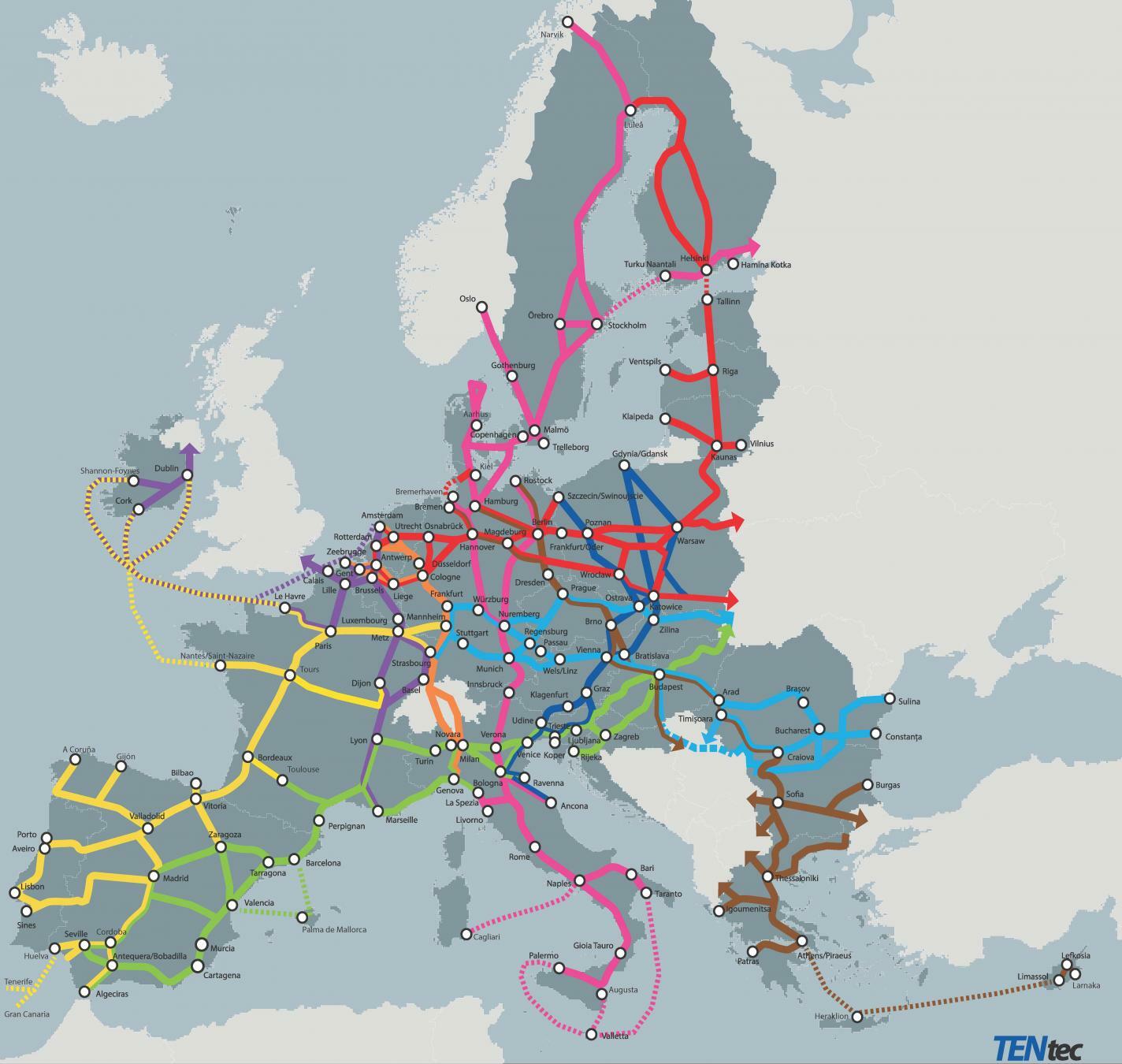Generic ETCS Level 2 Signal Engineering Rules (Part 1)
Designing a generic, European ruleset and safety logic for simplifying greenfield ETCS L2 FS projects without lineside signaling

Together with DB Netz AG and the Europe's Rail System and Innovation Pillars, Systems Lab 21 GmbH is researching on generic engineering guideline for signal planning in ETCS Level 2 Full Supervision without light signals (ETCS L2 w/o Signals) and their automation using software tools.
This is part one of a series of posts on the project.
ETCS Rollout Today
The first release of the ETCS specification was 26 years ago, in 1996. Since then, the standard has matured and the, as of today, stil latest release Baseline 3 Release 2 (B3R2) has already been published since 2016. ETCS has been implemented in vehicles and track-side across the globe but the approaches to the rollout vary widely.
While the ETCS specification as such is stable, each Railway Infrastructure Manager has followed their own strategy for national rollout. While some countries have only implemented a hand full of test tracks and individual lines, others have declared nation-wide implementation across their entire network.
The implementations vary from different ETCS levels and modes to various ATO over ETCS implementations (ATO = Automatic Train Operation), often with limited scope. Each line built often requires specially tailored designs and where different possible implementations exist, all implementations will eventually be built. An example of this are border crossings, where each border area comes with an own set of rules.
Overall, the ETCS rollout has been disappointing to many with regards to speed of adoption, kilometers covered and national specificities to consider. A recent study (1) found that over 50 percent of new railway cars taken into operation lack ETCS capabilities, citing several issues with the rollout and calling for a homogenized rollout of trackside and train-side equipment. This is partially because of interoperability and planning conflicts(2):
- Interoperability at RBC-RBC transitions (including border traffic)
- Compatibility with NTC and legacy systems
- Complex national operational guidelines
- No homogenous engineering guidelines, specifically for trackside signal engineering
- Uncertainty of migration paths between existing infrastructure and target ETCS level
In our work with DB Netz AG and the Europe's Rail System and Innovation Pillars, we are working to address some of these issues, specifically by developing a generic engineering guideline for signal planning in ETCS Level 2 Full Supervision without light signals (ETCS L2 w/o Signals).
Goals
While issues remain, the European Union remains committed to a large-scale ERTMS rollout with the goals of covering 97% of the core network (ca. 57,000 km) by 2030 and deployment to the comprehensive network by 2050. (4)
To aid these goals, a homogenized and interoperable implementation of trains, safety logic and infrastructure need to be accomplished.
Hence, the objectives of the project are threefold:
- The establishment of generic (i.e., nationally independent) signal engineering guidelines for the benefit of European ETCS corridors (greenfield approach)
- The further development of the Europe's Rail Data Model (ERDM) including signaling objects and attributes
- The formalization of the ruleset to ensure unambiguous interpretation and to allow for partial or fully automated planning
The result would be faster, more homogenous and parameterizable signal planning using a common data exchange format (ERDM) without the need to mitigate conflicts due to misaligned national guidelines.

Scope
The main goal is simplification to speed up implementation of projects and to deliver value for validation quickly, hence scope-reduction is key.
Engineering Rules and Safety Logic
The generic engineering rules make simplifications which have implications for the underlying safety logic. Where such implications exist, additional requirements and expectations towards the function of the safety logic are formulated. E.g. the use of level crossings or points which are not driveway-bound and connected to the interlocking is not permitted.
However, the ruleset does not specify a full safety logic.
ETCS L2 Without Signals
ETCS L2 without Signals was chosen because it currently represents a capacity- and cost-optimal solution for a wide range of scenarios. Specifically, the elimination of lineside signaling significantly reduces maintenance cost and delays due to equipment failure. Meanwhile, the introduction of ETCS may increase capacity by 30-40 percent which is especially relevant for crowded European networks and urban areas where other means of capacity increase (e.g., building new tracks) are not always available.
At the same time, the ruleset still relies on block-centric safety logic which is currently an established consensus for European safety regulations, as opposed to ETCS Level 3 or Hybrid L3 with cab-centric logic (moving block). The latter requires safe and precise positioning in all circumstances and is still facing practical issues for a large-scale rollout, while the former only requires good quality track data and regular repositioning at fixed positions (at regular intervals and before danger points).
Furthermore, the scope is reduced to encompass only greenfield projects without consideration of migration from existing NTCs (national train control systems). This approach was chosen due to studies that showed an ideal migration approach towards ETCS L2 is, whenever possible, a sole equipment according to ETCS L2 principles (rather than, e.g., doubly-equipping with light signals or migrations ETCS L1 => L2 or establishing backwards compatibility L2 => L1). Apart from lower cost, the removal of L1 or NTC field elements prevents reducing overall system availability due to "weakest link" components such as track circuits and light signals or elements approaching their end-of-life (3).
ETCS L2 without signals is also the choice for Infrastructure Managers in Norway and Denmark for their national rollout strategy as well as major projects across Europe, including the "Digital Node Stuttgart" by DB InfraGO and others.
Limited ETCS Modes
The main premise of the work is that all movement is supervised movement.
The removal of lineside signaling means that supervised movement in the ETCS modes Full Supervision (FS) or Onsight (OS) are strongly preferred for safety and efficiency reasons. The engineering rules thus come with a set of requirements towards safety logic and operational guidelines (rather than just one-way requirements towards the engineering) limiting the supported modes.
Even shunting shall be executed as supervised movement in OS, e.g., when coupling or decoupling trains inside stations. The next ERTMS TSI will also further support supervised shunting operations.
While there are still some arguments about fallback scenarios in cases where centralized ETCS components such as the RBC fail, it has been more widely accepted that redundant radio equipment and a reduced complexity due to removal of field elements is actually preferrable and more reliable than supporting a variety of fallback scenarios. Nevertheless, a contingency plan is necessary to avoid stranded vehicles whenever possible. This is why, besides supervised movement, the ETCS Mode Staff Responsible (SR) is allowed under certain restrictions.
Obviously, there are operational modes that do not impact the main principle stated at the beginning of this section, such as Trip (TR), Post Trip (PT), No Power (NP) etc. which will continue to find application. However, a limited supervision or NTC scenario is to be avoided on tracks planned with these guidelines as a lack of information on the HMI without the additional restrictions of Staff Responsible mode is unacceptable.
Application areas
Since the separation from legacy systems and rulesets closes graceful migration paths, the generic engineering rules would be best suited to equip newly built lines and transeuropean corridors like those of the Trans-European Transport Network. However, any railway line being newly equipped with signaling field elements may be an appropriate candidate.
By distinguishing between automated planning and plan checking, already existing plans could be checked against the ruleset as well, to discover rule violations or, respectively, where application of national guidelines differs from the generic rules.

The ruleset may be used for open tracks, stations, trusted areas, but not for shunting yards and parking areas (which are currently out-of-scope). It is agnostic to the distinction between main line or not.
Conclusions
ERTMS (respectively ETCS) rollout is a strategic objective to significantly increase the network capacity on the European railway network. Non-standardized implementation practices impede a speedy implementation, drive costs for infrastructure managers and vehicle manufacturers and cause issues with freight train operators.
ETCS L2 w/o signals is a stable and reliable baseline for standardization of infrastructure planning across national borders and will allow simplifications at the train-safety-logic, train-infrastructure and infrastructure-safety-logic interfaces.
National planning rules need to be taken out of the equation whenever possible to create a truly European, interoperable rail network.
We need accelerated, synchronized deployment of ERTMS for the whole TEN-T network, and the vehicles using it, by 2040, with a strong push on the Core Network already for 2030, a solid move to a radio-based ERTMS, a deadline for phasing out national signaling systems, a major renewal and refurbishment of locomotives and trainsets, better conditions for the mobilization of public funds (EU, national and regional) and private capital, and better transition management of technological progress ensuring that investments can be made in a predictable environment. (3)
In the following articles, we will describe the practical considerations with designing the engineering rules as well as implementation of software automation for planning and plan checking.
References
(1) Over half of new railway cars lack ETCS: ‘no business case’